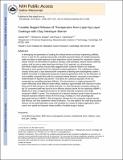| dc.contributor.author | Min, Jouha | |
| dc.contributor.author | Braatz, Richard D. | |
| dc.contributor.author | Hammond, Paula T. | |
| dc.date.accessioned | 2016-02-11T01:36:02Z | |
| dc.date.available | 2016-02-11T01:36:02Z | |
| dc.date.issued | 2013-12 | |
| dc.date.submitted | 2013-11 | |
| dc.identifier.issn | 01429612 | |
| dc.identifier.issn | 1878-5905 | |
| dc.identifier.uri | http://hdl.handle.net/1721.1/101154 | |
| dc.description.abstract | In developing new generations of coatings for medical devices and tissue engineering scaffolds, there is a need for thin coatings that provide controlled sequential release of multiple therapeutics while providing a tunable approach to time dependence and the potential for sequential or staged release. Herein, we demonstrate the ability to develop a self-assembled, polymer-based conformal coating, built by using a water-based layer-by-layer (LbL) approach, as a dual-purpose biomimetic implant surface that provides staggered and/or sustained release of an antibiotic followed by active growth factor for orthopedic implant applications. This multilayered coating consists of two parts: a base osteoinductive component containing bone morphogenetic protein-2 (rhBMP-2) beneath an antibacterial component containing gentamicin (GS). For the fabrication of truly stratified composite films with the customized release behavior, we present a new strategy—implementation of laponite clay barriers—that allows for a physical separation of the two components by controlling interlayer diffusion. The clay barriers in a single-component GS system effectively block diffusion-based release, leading to approximately 50% reduction in bolus doses and 10-fold increase in the release timescale. In a dual-therapeutic composite coating, the top GS component itself was found to be an effective physical barrier for the underlying rhBMP-2, leading to an order of magnitude increase in the release timescale compared to the single-component rhBMP-2 system. The introduction of a laponite interlayer barrier further enhanced the temporal separation between release of the two drugs, resulting in a more physiologically appropriate dosing of rhBMP-2. Both therapeutics released from the composite coating retained their efficacy over their established release timeframes. This new platform for multi-drug localized delivery can be easily fabricated, tuned, and translated to a variety of implant applications where control over spatial and temporal release profiles of multiple drugs is desired. | en_US |
| dc.description.sponsorship | National Institutes of Health (U.S.) (National Institute on Aging 5R01AG029601-03) | en_US |
| dc.description.sponsorship | National Cancer Institute (U.S.) (Koch Institute Support (Core) Grant P30-CA14051) | en_US |
| dc.language.iso | en_US | |
| dc.publisher | Elsevier | en_US |
| dc.relation.isversionof | http://dx.doi.org/10.1016/j.biomaterials.2013.12.009 | en_US |
| dc.rights | Creative Commons Attribution-NonCommercial-NoDerivs License | en_US |
| dc.rights.uri | http://creativecommons.org/licenses/by-nc-nd/4.0/ | en_US |
| dc.source | PMC | en_US |
| dc.title | Tunable staged release of therapeutics from layer-by-layer coatings with clay interlayer barrier | en_US |
| dc.type | Article | en_US |
| dc.identifier.citation | Min, Jouha, Richard D. Braatz, and Paula T. Hammond. “Tunable Staged Release of Therapeutics from Layer-by-Layer Coatings with Clay Interlayer Barrier.” Biomaterials 35, no. 8 (March 2014): 2507–2517. | en_US |
| dc.contributor.department | Massachusetts Institute of Technology. Department of Chemical Engineering | en_US |
| dc.contributor.mitauthor | Min, Jouha | en_US |
| dc.contributor.mitauthor | Braatz, Richard D. | en_US |
| dc.contributor.mitauthor | Hammond, Paula T. | en_US |
| dc.relation.journal | Biomaterials | en_US |
| dc.eprint.version | Author's final manuscript | en_US |
| dc.type.uri | http://purl.org/eprint/type/JournalArticle | en_US |
| eprint.status | http://purl.org/eprint/status/PeerReviewed | en_US |
| dspace.orderedauthors | Min, Jouha; Braatz, Richard D.; Hammond, Paula T. | en_US |
| dc.identifier.orcid | https://orcid.org/0000-0003-4304-3484 | |
| mit.license | PUBLISHER_CC | en_US |
| mit.metadata.status | Complete | |
